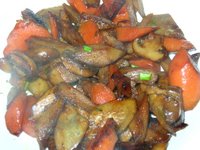Springtime is traditionally considered to be a good time to "cleanse the liver", or give it a nice restorative rest. One helpful practice is to choose not to eat foods that overstimulate the liver and gall bladder for at least a week or two -- fried and fatty foods, rich and sugary and salty foods, alcohol -- that is, those dark-of-winter holiday things that the bodymind craves for insulation and comfort when it's dark and cold and wet out for months on end. Not to mention dark.
As the sap begins to rise and the days grow lighter and muddier, our bodies begin to crave lightness, too, and to get the sludginess moving out. Eating bitter spring greens (dandelion, arugula, endive, chicory, mustard greens, and romaine lettuce is a little bit bitter too), which are little and tender and not so painfully bitter at this time of year, is a good way to gently stimulate liver secretion (bile production), which ferries out through the bowels many of the metabolic waste products the liver generates in its everyday intelligence.
Another plant food/medicine we prescribe often as a a liver/bowel/blood tonic is radix Arctium lappa,
 or burdock root. For a liver cleanse regime, burdock root is used in fluid extract or tea form, but for everyday you can also find beautiful long burdock roots (gobo in Japanese) at an Asian grocery store like Uwajimaya, or a natural foods grocery like our Puget Consumers Coop, and include it in your exotic vegetable repetoire. Here is a Japanese recipe I like, which is not a "liver cleanse" recipe because of the oil, sugar, sake and soy sauce (hmm--that's pretty much everything that's in it)
or burdock root. For a liver cleanse regime, burdock root is used in fluid extract or tea form, but for everyday you can also find beautiful long burdock roots (gobo in Japanese) at an Asian grocery store like Uwajimaya, or a natural foods grocery like our Puget Consumers Coop, and include it in your exotic vegetable repetoire. Here is a Japanese recipe I like, which is not a "liver cleanse" recipe because of the oil, sugar, sake and soy sauce (hmm--that's pretty much everything that's in it) Burdock or Carrot Kinpira (Kinpira Gobo or Ninjin) (adapted from Japanese Cooking, A Simple Art, by Shizuo Tsuji):
Burdock or Carrot Kinpira (Kinpira Gobo or Ninjin) (adapted from Japanese Cooking, A Simple Art, by Shizuo Tsuji):1 medium burdock root, or 3 medium carrots, (I usually include both and sometimes I add turnip or rutabaga or parsnip or some other rooty veg) peeled or very well-scrubbed
Oil for stir-frying
Cooking sake, a few TB
Soy sauce, a few TB
Sugar (I like brown sugar or sometimes honey in this recipe), 1 TB
1/4 tsp red pepper flakes or "Shichimi," Japanese "seven-spice mixture" which contains red pepper, roasted orange peel, yellow sesame seed, black sesame seed, Japanese pepper, seaweed, ginger, all ground up into sprinkles.
Sesame seeds and a scallion or two, sliced up, for garnish
Whittle the burdock into shavings, as if you were sharpening a huge pencil, and put the pieces in a bowl of water to keep them from turning too dark. I usually roll-cut them,
 but they are more delicate and not so chewy if you use the shaving method. I like them chewy. Cut the carrots, if using, into julienne or roll-cut them too. To roll-cut, you slice off a piece of the end, at an angle, then roll the vegetable a quarter turn or so, slice off another angled piece, etc. This makes for a lot of the tender & delicious inner-vegetable surface area to hit the hot oil when you get to the stir-fry step, but the pieces are more substantial and interesting than the eqivalent-sized regular slice.
but they are more delicate and not so chewy if you use the shaving method. I like them chewy. Cut the carrots, if using, into julienne or roll-cut them too. To roll-cut, you slice off a piece of the end, at an angle, then roll the vegetable a quarter turn or so, slice off another angled piece, etc. This makes for a lot of the tender & delicious inner-vegetable surface area to hit the hot oil when you get to the stir-fry step, but the pieces are more substantial and interesting than the eqivalent-sized regular slice.Heat a frying pan over high heat and add a few TB of oil, swirl to coat the bottom and when it's hot and ripply, throw in the vegetables and stir-fry for a few minutes until they start to soften up. You might have to turn down the heat a little to prevent scorching, depending on how sticky your pan is.
Then add the sake, soy sauce, and sugar or honey, reduce heat to medium high, and stir-fry till the liquid is thick and almost all reduced.
 If it sticks and scorches, add a little more sake. Flavor to taste with the red pepper or seven-spice sprinkles.
If it sticks and scorches, add a little more sake. Flavor to taste with the red pepper or seven-spice sprinkles.I like to add a spoonful of not-ground-up sesame seeds and some finely sliced scallion on top.
 Oh, but in the batch that's pictured I also added mushrooms (tasted good, texture was just OK) and I was out of sesame seeds.
Oh, but in the batch that's pictured I also added mushrooms (tasted good, texture was just OK) and I was out of sesame seeds.Good hot or at room temp, with a little sake (good drinking sake, not cheap cooking sake) or Japanese beer (another reason not to be doing a cleanse when you make this dish!)
No comments:
Post a Comment